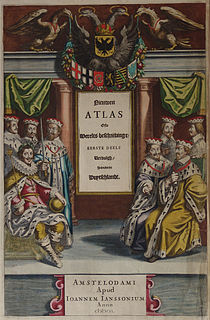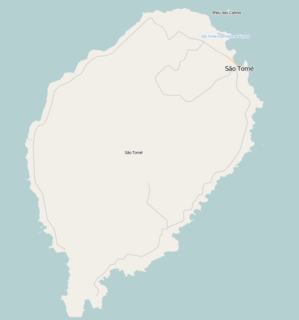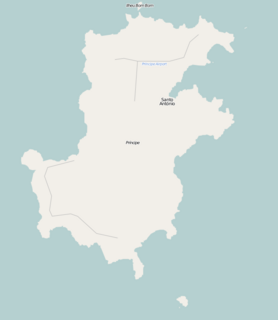Transport in São Tomé and Príncipe relies primarily on road infrastructure for local needs and airports and sea travel for international needs. São Tomé and Príncipe does not have railways.

Johannes Janssonius was a Dutch cartographer and publisher who lived and worked in Amsterdam in the 17th century.

Príncipe is the smaller, northern major island of the country of São Tomé and Príncipe lying off the west coast of Africa in the Gulf of Guinea. It has an area of 136 square kilometres (53 sq mi) and a population of 7,324 (2012). The island is a heavily eroded volcano speculated to be over three million years old, surrounded by smaller islands including Ilheu Bom Bom, Ilhéu Caroço, Tinhosa Grande and Tinhosa Pequena. Part of the Cameroon Line archipelago, Príncipe rises in the south to 947 metres at Pico do Príncipe. The island is the main constituent of the Autonomous Region of Príncipe, established in 1995, and of the coterminous district of Pagué.

Jodocus Hondius was a Flemish engraver and cartographer. He is sometimes called Jodocus Hondius the Elder to distinguish him from his son Jodocus Hondius II. Hondius is best known for his early maps of the New World and Europe, for re-establishing the reputation of the work of Gerard Mercator, and for his portraits of Francis Drake. One of the notable figures in the Golden Age of Dutch/Netherlandish cartography, he helped establish Amsterdam as the center of cartography in Europe in the 17th century.

Ilhéu Raso is an uninhabited 5.76 square kilometres volcanic island in the Barlavento archipelago of Cape Verde. It is flanked by the smaller Branco islet to the west and by São Nicolau island on its eastern side, distance is 15 kilometres from the island of São Nicolau. Together with Santa Luzia and Ilhéu Branco, Ilhéu Raso is on the tentative list of UNESCO's World Heritage sites. Since 1990, the islet is part of the protected area Reserva Natural Integral de Santa Luzia.

Ilhéu Branco is an uninhabited 278 ha islet in the Barlavento group of the Cape Verde archipelago off the coast of north-west Africa in the Atlantic Ocean. Ilhéu Branco is flanked by the islands of Santa Luzia to the north-west and Ilhéu Raso to the south-east. Since 1990, the islet is part of the protected area Reserva Natural Integral de Santa Luzia. Together with Santa Luzia and Ilhéu Raso, Ilhéu Branco is on the tentative list of UNESCO's World Heritage sites.

Pico de São Tomé is the highest mountain in São Tomé and Príncipe at 2,024 m (6,640 ft) elevation. It lies just west of the centre of São Tomé Island, in the Parque Natural Obô de São Tomé and in the Lembá District. The second highest point, Pico de Ana Chaves, lies about 3 km to its south east. The town Santa Catarina is 8 km to the west.

Ilhéu das Rolas is an islet in the African island nation of São Tomé and Príncipe. The island lies on the equator, off the southern tip of São Tomé Island, separated by Canal das Rolas. Its maximum elevation is 96 m. Its population is 76. It is part of the Caué District. Access is only by ferry departing from Ponta Baleia on São Tomé Island. There is a lighthouse on the islet, built in 1929. Its focal height is 106 meters and its range is 12 nmi. The island is home to a small resort, the Pestana Equador.

Santana is a town on the eastern coast of São Tomé Island, which is part of the island nation of São Tomé and Príncipe. It is the seat of Cantagalo District. The population of Santana with the adjacent settlements Cidade Alta, Cova Água, Gomes, Nova Olinda, Picão Flor, Praia Messias Alves, Riboque Santana and Zandrigo is 10,290 (2012).2012 detailed census São Tomé e Príncipe, Instituto Nacional de Estatística</ref> Santana lies 9 km south of the capital São Tomé and 17 km northeast of São João dos Angolares. The islet Ilhéu de Santana lies about 1 km off-shore, 2.5 km southeast of Santana.

Ilhéu das Cabras is an uninhabited island in the Gulf of Guinea. It is one of the smaller islands of São Tomé and Príncipe. The islet is located about 2 km off the northeast coast of the island of São Tomé, 8 km north of the city centre of São Tomé. The islet consists of two hills, about 90 metres high. There is a lighthouse on the northeastern summit, built in 1890; its focal height 97 metres and its range is 12 nmi. The islet was mentioned as "Mooro Caebres" in the 1665 map by Johannes Vingboons.

Ilhéu Caroço is an uninhabited islet in the Gulf of Guinea, part of São Tomé and Príncipe. The islet is located southeast of the island of Príncipe, about 3 km off the coast. Its area is about 0.4 km². The islet is steep, rocky and wooded, and rises to 305 metres elevation.

Tinhosa Grande is an uninhabited islet in São Tomé and Príncipe, located 23 km (14 mi) southwest of the island of Príncipe and 124 km (77 mi) northeast of the island of São Tomé. Together with the smaller islet Tinhosa Pequena, 4 kilometers to its north, it forms the Pedras Tinhosas group. It is 55 metres high, and its area is 20 hectares.

Tinhosa Pequena is an uninhabited islet in São Tomé and Príncipe, located 20 km (12 mi) southwest of the island of Príncipe and 127 km (79 mi) northeast of the island of São Tomé. Together with the larger islet Tinhosa Grande, 4 kilometers to its south, it forms the Pedras Tinhosas group. It is 64 metres high, and its area is 3 hectares.

Ana Chaves Bay is a bay on the northeast coast of São Tomé Island in São Tomé and Príncipe. The capital city of São Tomé and its port are situated by the bay. It stretches from the Ponta Oque del Rei in the north to Ponta São Sebastião in the south. Forte de São Sebastião, now part of São Sebastião Museum, occupies Ponta São Sebastião. The port of São Tomé was built at the end of the 1950s on reclaimed land that extends 0.2 miles (0.32 km) north of Ponta São Sebastião; there is a 200 m quay at its north end, with a depth of 3 metres alongside. It is the main port of the country for solid goods; the port of Neves is the main point of entry for liquid fuels. The bay is generally shallow, offering anchorage for small vessels in depths of less than 5 metres (16 ft).

Sete Pedras is a group of rocky islets in the Gulf of Guinea, part of São Tomé and Príncipe. The islets lie about 2.5 nmi (4.6 km) off the southeast coast of the island of São Tomé. The largest islet is 42 metres high. The islets were mentioned as "Seven Steen" in the 1665 map by Johannes Vingboons.

Pedra da Galé is an uninhabited islet in the Gulf of Guinea, part of São Tomé and Príncipe. It lies 3.7 km westnorthwest the north coast of the island of Príncipe. It is 190 meters long and up to 60 meters wide in its northern part, and four meters high. Since 2012, the islet forms a part of the Island of Príncipe Biosphere Reserve.

Ilhéu dos Mosteiros is an uninhabited islet in the Gulf of Guinea, part of São Tomé and Príncipe. It lies about 0.8 km off the northeast coast of the island of Príncipe. It is 20 metres high. Since 2012, the islet forms a part of Island of Príncipe Biosphere Reserve.

Ilhéu do Farol is an uninhabited islet off the easternmost point of Madeira Island, Portugal. It is part of the municipality of Machico. The islet lies adjacent to the east of the larger Ilhéu da Cevada, which lies directly east of the rocky peninsula Ponta de São Lourenço. Its area is 11.5 ha. The islet is 107 meters high. A lighthouse stands at the eastern extremity of the island. The islet is part of the protected area Reserva Natural da Ponta de São Lourenço.




















